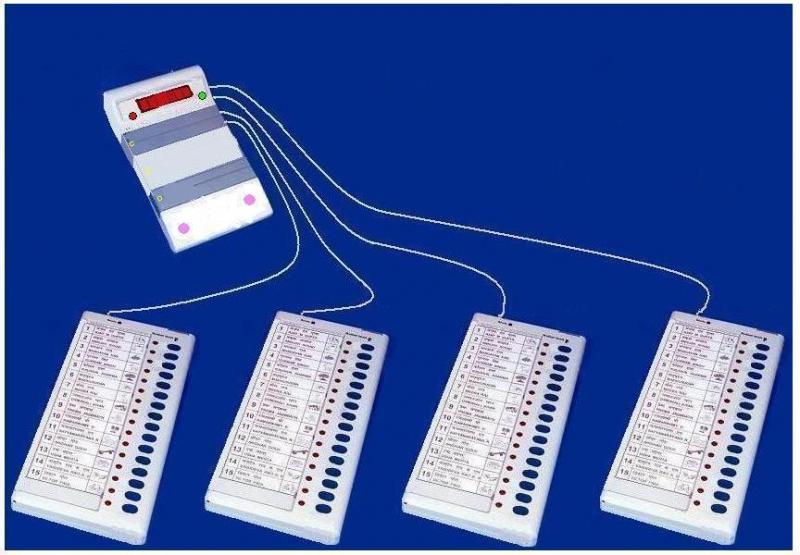Electronic voting systems for electorates have been in use since the 1960s which back then was done using Punch cards. The first major usage of E-Voting was in US for 1964 presidential election. In India usage of Electronic Voting Machines was tried partially in 1999. In 2004 general elections the total usage of EVMs came into force and paper ballot boxes were completely phased out. The EVMs used in our country are manufactured by Bharat Electronics Ltd., Bangalore and Electronic Corporation of India Ltd., Hyderabad, while it was designed by faculty members at the Industrial Design Centre, IIT Bombay.
An EVM consists of two connected units. When Polling Officer in-charge presses the Ballot Button in Control Unit it will enable the voter to cast his vote on Balloting Unit. Once a vote is cast, the Balloting Unit is locked until it is unlocked again by the Control Unit. EVMs are powered by an ordinary 6 volt alkaline battery so that they are not dependent on electricity which may not be available in remote areas. One EVM can cater to a maximum of 64 candidates and a maximum of 4 EVMs can be linked in parallel, in case the number of candidates is more.
 EVMs reduce the time in both casting a vote and declaring the results compared to the old paper ballot system. With a little initial investment in EVM, for the device itself there can be made huge savings on the printing, papers, transportation, storage and counting staff. Bogus voting can be reduced as EVM is programmed to record maximum of only five votes in a minute. The vote count is stored in the control memory and can be kept in there as long as necessary. It has been estimated that about 10,000 tons of ballot paper (roughly 200,000 trees) would be saved by the usage of EVM.
EVMs reduce the time in both casting a vote and declaring the results compared to the old paper ballot system. With a little initial investment in EVM, for the device itself there can be made huge savings on the printing, papers, transportation, storage and counting staff. Bogus voting can be reduced as EVM is programmed to record maximum of only five votes in a minute. The vote count is stored in the control memory and can be kept in there as long as necessary. It has been estimated that about 10,000 tons of ballot paper (roughly 200,000 trees) would be saved by the usage of EVM.
It has to be noted that technology cannot be guaranteed to be completely accurate and it is a very hard problem in computer science as it is not practical to design fully error-free and reliable computing equipment, the same being with EVMs. Time and again several questions have been raised over the usage of this technology for the most important decision of a nation. The most prominent ones are the writ petition of Mr. Subramanian Swamy in Delhi High Court in 2009, Election Petition by Congress Candidate Alok Jena in Orissa High Court in 2009, writ petition by Rajendra Satyanarayan Gilda in 2011 and writ petition filed by Asom Gana Parishad pending before the Gauhati High Court. The concern of almost all of them is with regards to the transparency.
When the debate over usage of technology for election was triggered in Germany the argument put forth reflects the above thought i.e. when electronic voting machines are deployed, it must be possible for the citizen to check the essential steps in the election act and in the ascertainment of the results reliably and without special expert knowledge. But this is not possible as the computing devices are sufficiently complex needing expertise to determine their infallibility. With the idea that in a republic, elections are a matter of the entire people and a joint concern of all citizens, Germany has been skeptical in adopting e-voting though a lot of certification process for various methods is under process.
 It has to be noted that EVMs are easy to tamper. In April 2010, an independent security analysis of India’s Electronic Voting Machines was released which also included video demonstrations of two of the attacks, where first method involved manipulating the EVM before the voting to steal a percentage of votes in favor of a particular candidate while second method involved manipulating the vote storage memory post election by connecting a device and swapping the votes. The Election Commission (EC) of India rejected these arguments based on two points. Firstly, for both the methods to work, one needs physical access to EVMs and pretty high tech skills. Given that EVMs are stored under strict security it’s impossible to gain physical access to the machines. Secondly, to make an impact on the election result a large number of EVMs have to be tampered with. We can say that our election results are as secure and safe as are our EVMs and that democratic hacking will be needed for modifying our democratic results.
It has to be noted that EVMs are easy to tamper. In April 2010, an independent security analysis of India’s Electronic Voting Machines was released which also included video demonstrations of two of the attacks, where first method involved manipulating the EVM before the voting to steal a percentage of votes in favor of a particular candidate while second method involved manipulating the vote storage memory post election by connecting a device and swapping the votes. The Election Commission (EC) of India rejected these arguments based on two points. Firstly, for both the methods to work, one needs physical access to EVMs and pretty high tech skills. Given that EVMs are stored under strict security it’s impossible to gain physical access to the machines. Secondly, to make an impact on the election result a large number of EVMs have to be tampered with. We can say that our election results are as secure and safe as are our EVMs and that democratic hacking will be needed for modifying our democratic results.
Voter-verified paper audit trail (VVPAT) or verified paper record (VPR) is a method of providing feedback to voters. A VVPAT is intended as an independent verification system for voting machines designed to allow voters to verify that their vote was cast correctly. In this system on pressing of each vote, a paper receipt will be printed and dropped in a box, which will be visible to the voters inside a glass case but cannot be taken out. This brings back the paper era and the saving done on environment by the EVM is partially lost. However, the vote counting is still faster due to the usage of EVM for it while the paper trail can be used for cross-verification incase the results are challenged.
The PIL of Mr. Swamy was dismissed by the Delhi High Court on 17th January 2012 refusing to direct the EC to bring back paper-ballot system or use of printed receipts. Mr. Swamy appealed against this in Supreme Court and so on 27th Sep 2012 EC submitted to a Supreme Court bench that field trial for VVPAT is in progress and status report will be submitted by early January 2013. Subsequently VVPAT was introduced in 8 of 543 parliamentary constituencies as a pilot project in 2014 general election. The author was able to experience VVPAT system first-hand from Bangalore South constituency.
Strangely, E-voting is not the current trend in other counties, including those considered technologically advanced.
There has been another experiment done in Gujarat in regards to the usage of technology in elections with E-voting. With Gujarat Informatics Ltd as the advisor, TCS as the software provider and Vadodara-based Indusface, an information security agency and to maintain servers the team has the complete set-up for handling online voting. It was first experimented in a few constituencies in Gujarat during civic elections held on October 10th, 2010. Though the response was low, in April 2011 elections to the Gandhinagar Municipal Corporation there was 74% E-voting out of those who had registered for it. To register for E-voting one has to fill in the form submitting personal as well as laptop/desktop details to be used for E-voting. New passwords are generated on the day of election for additional security. Things here are not all smooth as there have been glitches with some of the users and also hacking attacks from international locations that had to be defended. Strangely, E-voting is not the current trend in other counties, including those considered technologically advanced. Probably that is why E-voting has not been rolled out across the nation on a large scale and not used in recent general elections.
Technology and security always go hand in hand in case of complexity and ease. The more complex a technology, the more ease it can accommodate and the more complex and difficult its security becomes. In case of elections in a general republic, technology has played a very limited role, probably the reason being this issue of security. Ballot paper vote or E-vote both can be fudged by various means as the end is the human element that is influenced by various methods including by the media, prejudices, favors and other personal considerations. If a republic has to be truly democratic then the general public has to be enough informed not to be influenced by external factors and take the informed right decision. Development of technology in this direction may result in much better results in promoting and saving the true spirit of democracy.







Strangely E-voting is not the choice in technologically advanced countries!!!
while India choose to be a less advanced country….
[…] स्रोत […]